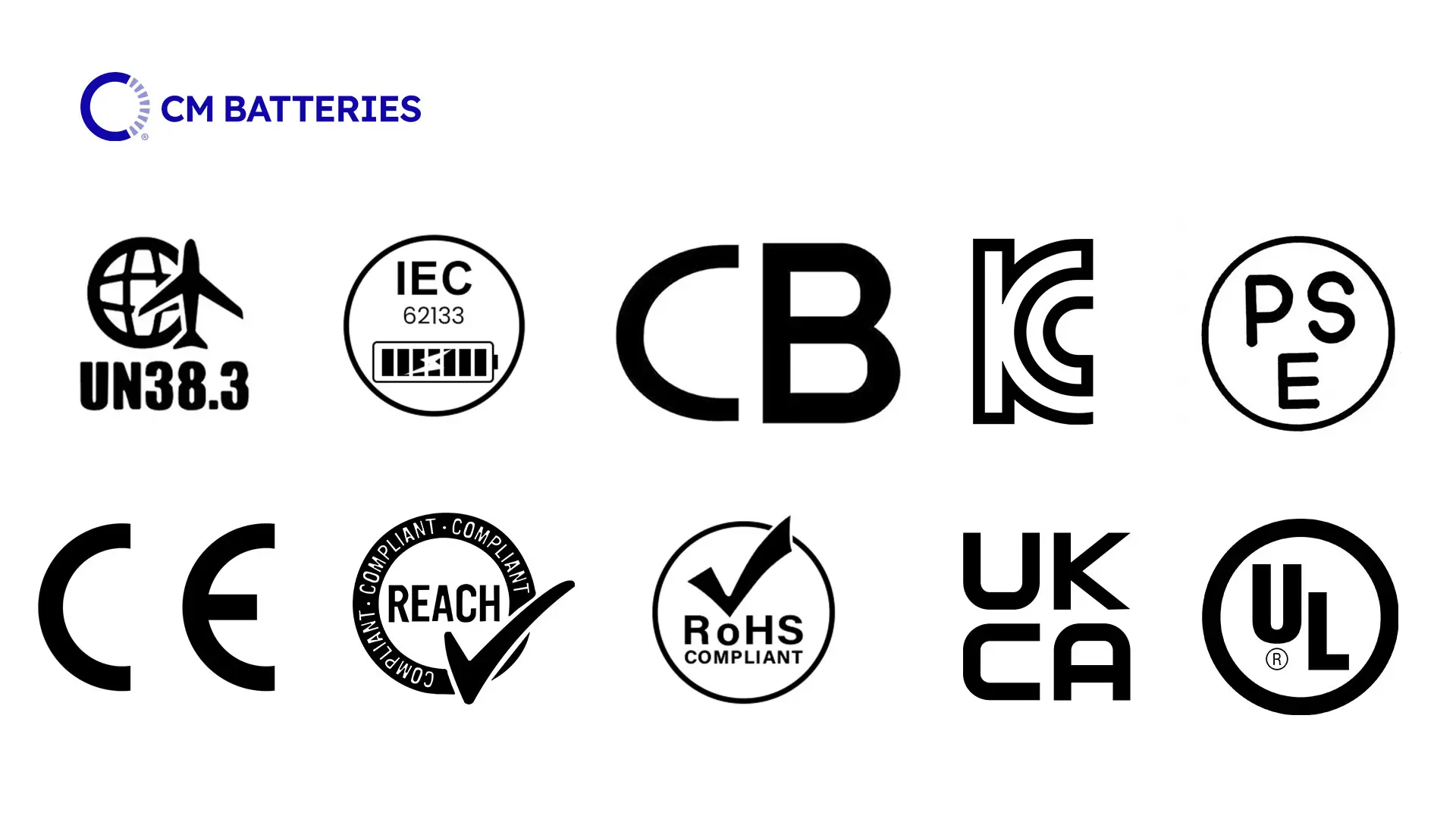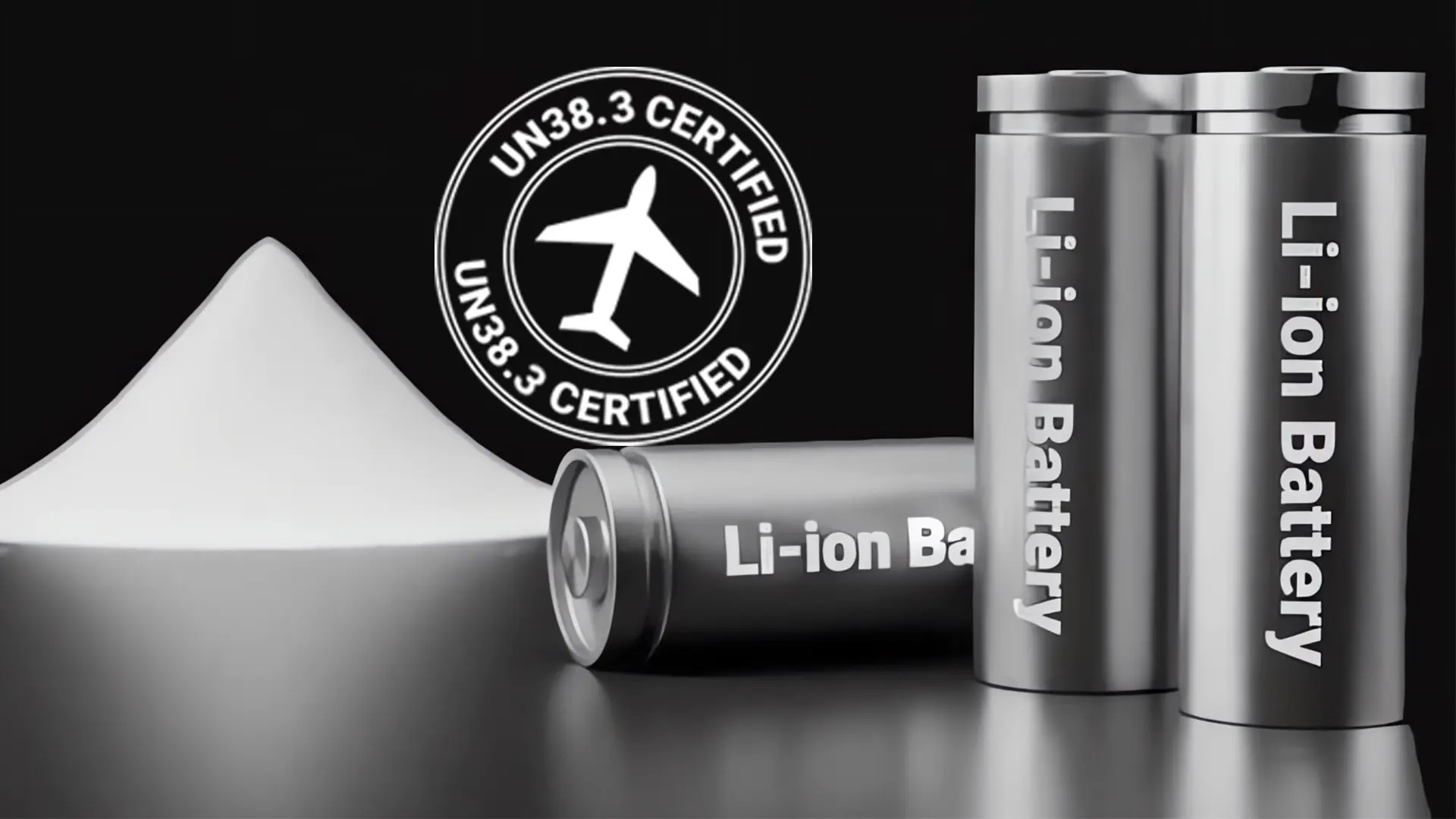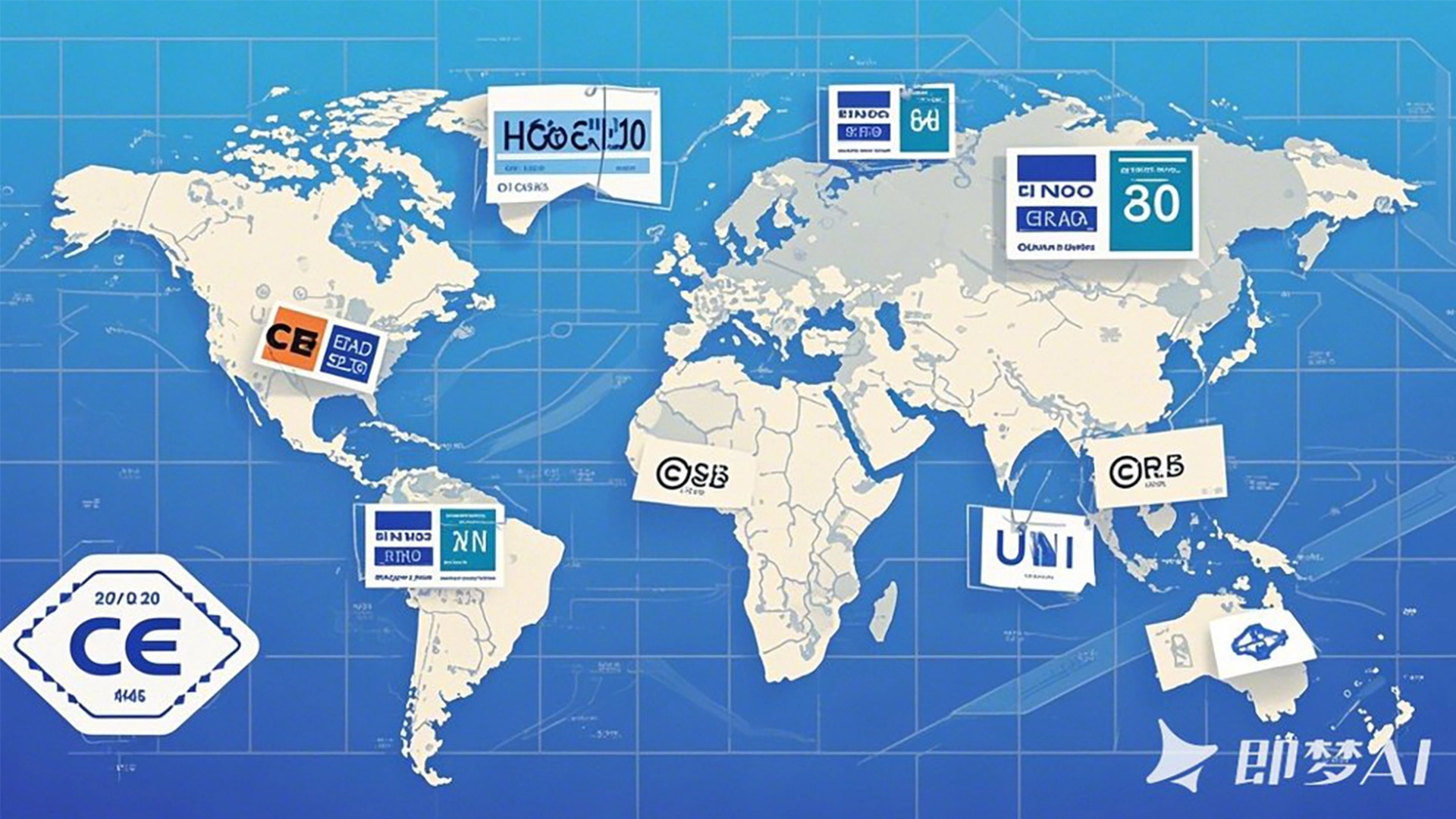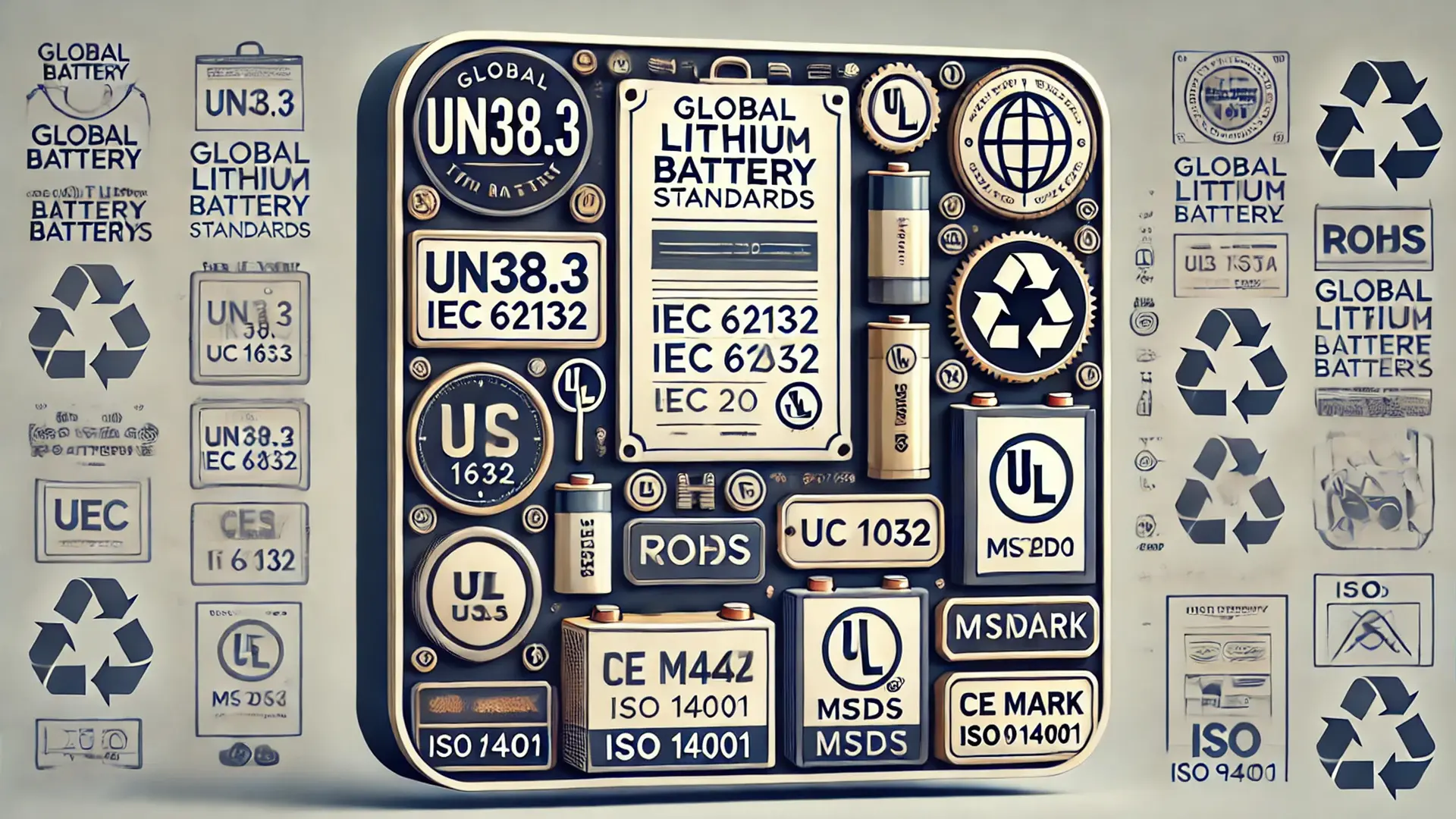At CM Batteries, we believe safety isn’t just a feature—it’s the foundational principle of every custom battery pack we engineer. As a trusted manufacturer, we build compliance directly into our lithium-ion battery designs from the very first schematic, ensuring safety is achieved, not merely checked.
Global certifications like UN38.3, IEC 62133, UL, KC,PSE and CE represent more than just regulatory checkbox—they are your tangible assurance of rigorous risk management, supply chain integrity, and seamless market readiness.
This guide is designed to demystify the complex world of lithium battery certifications—not as a theoretical overview, but as a practical resource for engineers, product managers, and procurement specialists who need to make informed decisions about their power solutions. By the end, you’ll understand not just what each certification means, but how the right manufacturing partner can turn compliance from a barrier into a competitive advantage for your products.

Why Certification Expertise is Integral to Your Battery Supplier Selection?
Your battery supplier with deep certification expertise becomes a strategic asset, directly impacting your project’s cost, speed, and long-term security.
- Control Certification Costs. A qualified battery supplier provides an optimal certification roadmap for your specific project phase. This proactive, expert-guided approach prevents costly design revisions and retesting, ensuring you pay for a path to approval—not for unexpected setbacks.
- Accelerate Time-to-Market by 20–50%. Speed is critical. A manufacturer with a proven track record and established lab relationships can dramatically compress your timeline. Their engineering team designs for compliance from the outset—from PCB to final pack assembly—while expertly prepared documentation streamlines the entire process, getting your product to market faster.
- Ensure Long-Term Supply Chain Stability. Global regulations constantly evolve. Your supplier’s ability to proactively monitor and adapt to these changes is not optional; it’s essential for your product’s continued market access. A partner with a dedicated compliance team ensures your battery packs remain certified, protecting you from future disruptions or costly recalls.
A Guide to The 10 Most Popular Battery Certifications
UN38.3 Certification
UN38.3 was created by the United Nations Committee of Experts on the Transport of Dangerous Goods and is the United Nations’ standard that lithium batteries must meet to be certified as safe to transport. The certification tests the batteries for a variety of safety hazards, including:
- Altitude simulation
- Thermal test
- Vibration
- Shock
- External short circuit
- Impact
- Overcharge
- Forced discharge
What Does a UN38.3 Certification Include?
This certification includes:
- A UN38.3 test report
- A UN38.3 lithium battery test summary
- An MSDS report
- An Identification and Classification Report for the transport of goods by sea
- An Identification and Classification Report for the transport of goods by air
What is the Period of Validity for a UN38.3 Certification?
The UN38.3 certification requires revalidation when regulations change. Its supporting documents—including the Summary Test Report, MSDS, and Transportation Classification Report—are typically valid for one year and should be updated annually.
To verify the current status of your battery certification or request the latest documents, please contact us.
What is the Difference Between UN3480 and UN3481?
| Specification | UN3480 | UN3481 |
| Lithium battery type | Batteries must be packed to prevent short-circuiting and overheating. The packaging must also be labeled with the UN3481 classification number. | Lithium batteries contained in or packed with equipment |
| Packaging requirements | Batteries must be individually packaged and packed in a strong outer packaging that is resistant to impact and vibration. | Batteries must be packed in a way that prevents short-circuiting and overheating. The packaging must also be labeled with the UN3481 classification number. |
| Transportation regulations | Batteries must be shipped in accordance with the UN Recommendations on the Transport of Dangerous Goods (TDG). | Batteries must be shipped in accordance with the TDG, and the specific requirements of the mode of transport being used. |
What is the UN classification of lithium batteries?
All lithium batteries are considered Class 9, which means they are classified as Miscellaneous Dangerous Goods. The UN38.3 certification is a test standard that lithium batteries must meet to be classified as Class 9.
How Many Packing Instructions are There in Section II of Lithium Batteries?
The UN38.3 certification outlines the packaging requirements for lithium batteries classified as dangerous in Class 9.
Section II of the UN38.3 standard includes three packaging instructions:
PI965 applies to lithium batteries packed separately from equipment.
PI966 applies to lithium batteries packed with equipment in the same outer packaging.
PI967 applies to lithium batteries installed in equipment.
The required packing instruction depends on the battery type, quantity, and mode of transportation.
IEC62133 Test Report
The IEC62133 test report compliance is certified to the latest international standard, IEC 62133-2:2017. This standard rigorously evaluates the safety of lithium-ion batteries through a series of electrical, mechanical, and environmental tests (e.g., overcharge, short circuit, crush, thermal abuse) under normal use, foreseeable misuse, and fault conditions, minimizing risks such as fire and explosion.
What Does the IEC62133 Lithium Battery Pack Certification Test Consist of?
The IEC62133 certification process includes the following:
- Design recommendations
- Charging procedure for testing purposes for cells and batteries
- Continuous cell charging at constant voltage
- External short-circuiting of cells
- External short-circuiting of batteries
- Cell-free falls
- Battery-free falls
- Thermal abuse of cells
- Crushing of cells
- Over-charging of battery
- Forced discharging of cells
- Mechanical battery tests
If a lithium battery passes the IEC62133 tests, it can be considered safe for use in portable applications.
What is the Period of Validity for an IEC62133 Certification?
The IEC 62133 test report does not have a fixed validity period. However, as per market practice, clients typically require a recent report issued within the last 1-3 years to demonstrate ongoing compliance and consistent production quality.
CB Certification
The CB Scheme, overseen by the International Electrotechnical Commission (IECEE), is a global framework for the mutual recognition of product safety certifications. For lithium-ion battery packs, it streamlines international market access by allowing a single certification to serve as a basis for national approvals in over 50 participating countries.The CB certification is issued by TUV Rheinland.
What Does CB Certification for Li-ion Battery Packs Include?
CB Certification for lithium-ion battery packs is fundamentally based on compliance with the IEC 62133 safety standard, providing a recognized benchmark for professional evaluation. The process encompasses several critical components:
Compliance Testing & Verification
Conducting rigorous safety tests as per IEC 62133, including but not limited to short circuit, impact and drop, thermal abuse.
Evaluation of Safety Features
Thorough assessment of key safety designs and components, such as the BMS, cell protection mechanisms, and the integrity of the enclosure and insulation.
Documentation & Reporting
Preparation and review of comprehensive technical documentation, test reports, and construction data to demonstrate full compliance.
Labeling & Marking Requirements
Verification that the product is correctly marked with all required safety symbols, ratings, and compliance information.
Factory Inspection (as required)
Assessment of the manufacturing facility’s quality control processes to ensure ongoing production consistency with the certified model.
PSE Certification
PSE (Product Safety of Electrical Appliance & Material) is a mandatory safety certification for the Japanese market.As one custom battery packs manufacturer,most of our product meet the diamond-Shaped PSE (Specified Electrical Products): Applies to higher-risk products. For lithium batteries, this primarily includes portable lithium-ion batteries with an energy density exceeding 400Wh/L.
What Does the PSE Certification for Lithium Batteries Test Consist of?
PSE certification is primarily based on safety testing against the Japanese standards JIS C 8712 (aligned with IEC 62133) and JIS C 8714 (aligned with IEC 61960). The core test items are similar to IEC 62133 but include additional specific requirements of Japanese regulations.
The PSE test and certification process includes:
- Safety Testing: External short circuit, overcharge, forced discharge, crush, impact (free fall), thermal abuse, etc.
- Labeling and Documentation Review: Ensures product markings and instructions comply with Japan’s detailed Electrical Appliance and Material Safety Law requirements, including mandatory PSE mark, ratings, and manufacturer information.
- Factory Inspection (for Diamond PSE): An audit of the factory’s quality control system to ensure mass production is consistent with the certified sample.
- Market Surveillance: Products are subject to random testing by METI after entering the Japanese market, with penalties for non-compliance.
What Does a PSE Certification Include?
- A detailed PSE test report.
- For Diamond PSE products, a Certificate of Conformity issued by the certification body.
What is the Period of Validity for a PSE Certification?
Diamond PSE Certificate: Typically valid for 3 to 7 years, with the exact period determined by the certification body based on product risk. Renewal is required upon expiration.
After obtaining PSE certification, “METI Filing” must be completed before products can be placed on the Japanese market. Only a company registered in Japan (your local importer) can act as the “Declarer” to complete this filing. Close cooperation with your Japanese importer is essential to provide them with the PSE certificate or test report for filing.
KC Certification
The KC Mark (Korea Certification) is a mandatory safety certification for products sold in the South Korean market. It is administered by the National Radio Research Agency (RRA) and the Korean Agency for Technology and Standards (KATS), ensuring that electrical and electronic products meet strict safety, EMC (Electromagnetic Compatibility), and energy efficiency regulations.
What Does KC Certification for Lithium ion Battery Packs Include?
KC certification (KC 62133-2) for lithium-ion battery packs primarily includes:
- Comprehensive safety testing covering both normal and abusive conditions.
- Technical documentation
- Compliance review of the manufacturing facility.
For lithium ion battery packs that already hold a valid CB certificate, a simplified CB-to-KC conversion process can be implemented through a designated Korean agency (such as KTC) to complete registration. This avoids redundant testing and saves both time and cost.
What is the Period of Validity for a KC Certification?
While the KC certificate itself has a 5-year validity period, its effectiveness is conditional on maintaining product consistency and passing market surveillance. It is not a “set-and-forget” approval but requires active maintenance and communication with the certification body regarding any changes.
UL Certification
For lithium-ion battery packs, Underwriters Laboratories (UL) certification is the global gold standard, assuring our customers of rigorous safety testing. There are two primary UL certification types relevant to battery packs, and understanding the distinction is crucial for your product compliance.
- UL 62133-2 (Component Recognition)
This certification is for battery packs intended to be sold as components to other manufacturers (OEMs/ODMs) for integration into their end-use products.
- UL 2054 (Product Listing)
This is a more comprehensive certification for battery packs that are finished, standalone products sold directly to consumers at retail.
While UL 62133-2 is sufficient for component sales, we strongly advise our customers to certify their battery packs to UL 2054 standards directly. UL 2054 involves a more stringent set of tests that simulate real-world misuse and extreme conditions a consumer product might face, offering a higher level of safety assurance and market acceptance.
What Does the UL 2054 Test Report Include?
The UL 2054 certification process involves a exhaustive series of tests designed to evaluate electrical, mechanical, and environmental safety under both normal and abusive conditions. A comprehensive test report typically consists of the following key sections:
- Electrical Tests: Overcharge, short circuit, abnormal charging, forced discharge.
- Mechanical Tests: Crush, impact, shock, vibration, drop test.
- Environmental Tests: Heating (thermal stability), temperature cycling, mold stress relief.
- Fire Exposure Test: Assesses the battery’s reaction when exposed to fire.
- Construction Review: Detailed examination of internal components, materials, spacing (creepage and clearance), and labeling.
- Performance Data: Capacity verification and ratings.
This rigorous testing ensures the battery pack will not pose fire, electrical, or explosion hazards during its intended use and foreseeable misuse.
What is the Period of Validity for a UL 2054 Certification?
A UL 2054 Listing is not a one-time event with an expiry date. It is an ongoing certification maintained through a follow-up services agreement. Here’s how it works:
- Initial Certification: Once the product passes all tests and construction is approved, it is listed in UL’s database.
- Continued Validity: To maintain the valid listing, manufacturers must agree to UL’s FUS. UL inspectors conduct periodic, unannounced audits at our production facilities.
- Audit Focus: These audits verify that we continue to produce the battery pack exactly as the originally submitted and approved sample (no unauthorized changes to materials, components, or design) and that our production processes maintain consistent quality.
- Consequence of Non-Compliance: If changes are made without UL’s review and re-testing, or if audits find non-compliance, the UL Listing can be suspended or withdrawn.
CE Certification
CE certification confirms that the manufacturer has assessed the product and ensured it meets EU safety, health, and environmental protection standards. This certification is mandatory for any product sold in the European Union.
What Does the CE Certification Test Consist of?
The testing process for CE certification can vary depending on the product and the relevant EU directives. However, it typically includes the following steps:
- The manufacturer identifies the relevant EU directives that apply to their product.
- The manufacturer assesses whether their product meets the requirements of the relevant EU directives.
- If the product does not meet the requirements, the manufacturer must take steps to bring it into compliance.
- The manufacturer may need to have their product tested by a third-party certification body.
- If the product passes the tests, the manufacturer will be issued a CE certificate.
What is the Period of Validity for a CE Certification?
CE marking is not a traditional certification with a fixed expiry date, but a declaration of ongoing conformity. The manufacturer remains responsible for ensuring continuous compliance with relevant EU directives throughout the product’s lifecycle. In practice, the associated technical documentation and Declaration of Conformity are typically considered valid for five years, after which they should be reviewed and updated if necessary.
UKCA Certification
The UKCA marking is required following the United Kingdom’s departure from the European Union on January 31, 2020. As the UK is no longer bound by EU regulations, including the CE marking scheme, the UKCA marking has been introduced to ensure that products placed on the market in Great Britain continue to uphold rigorous standards of safety, health, and environmental protection.
What Does the UKCA Certification Test Consist of?
The testing process for UKCA certification depends on the specific product and the applicable UK legislation. In general, it involves the following steps:
- The manufacturer determines which UK statutory requirements apply to their product.
- The manufacturer evaluates whether the product complies with all relevant UK legal standards.
- If the product does not meet these requirements, the manufacturer must implement necessary modifications to achieve compliance.
- For certain product categories, the manufacturer may be required to engage an approved third-party conformity assessment body to conduct testing.
- Upon successful verification of compliance, the manufacturer may affix the UKCA mark and prepare the required declaration of conformity.
What is the Period of Validity for a UKCA Marking?
The UKCA marking does not have a fixed expiration date; however, it is typically considered valid for a period of five years. During this time, the manufacturer must ensure the product continues to comply with all applicable UK legislation and technical standards. If significant changes are made to the product design, applicable regulations, or conformity assessment procedures, the manufacturer is responsible for reviewing and, if necessary, updating the product’s compliance documentation and reassessing its conformity to the UKCA requirements.
RoHS Certification
The Restriction of Hazardous Substances (RoHS) Directive is a critical environmental regulation enforced in the European Union and many global markets, including the United Kingdom. It aims to restrict the use of specific hazardous substances in electrical and electronic equipment to protect human health and the environment.
What Does the RoHS Certification Test Consist of?
According to the EU RoHS Directive (2011/65/EU) and its amendment (EU) 2015/863, the maximum permitted concentration for the following ten substances is 0.1% (1000 ppm) by weight in homogeneous materials, with the exception of cadmium:
- Lead (Pb)
- Mercury (Hg)
- Cadmium (Cd) – Limit: 0.01% (100 ppm)
- Hexavalent Chromium (Cr VI)
- Polybrominated biphenyls (PBB)
- Polybrominated Diphenyl Ethers (PBDE)
- Bis(2-ethylhexyl) phthalate (DEHP)
- Benzyl butyl phthalate (BBP)
- Dibutyl phthalate (DBP)
- Diisobutyl phthalate (DIBP)
REACH Compliance
Our lithium-ion battery packs are manufactured to meet the requirements of the EU REACH Regulation (EC) 1907/2006.
What is the Core of REACH Compliance?
REACH compliance centers on two main responsibilities for product manufacturers:
- Substance Restrictions (Annex XVII)
This section prohibits or limits the use of specific hazardous substances in products. Compliance requires ensuring that no substance listed in Annex XVII is present in our products above the specified limits. - Communication of SVHCs (Articles 7 & 33)
If a product contains any Substance of Very High Concern (SVHC) from the official Candidate List at a concentration above 0.1% (weight by weight), we are obligated to:
Provide sufficient safety information to professional customers.
Provide the same information to consumers upon request within 45 days.
Submit information on such articles to ECHA’s SCIP database (as required since January 2021).
Battery Certification: Cost & Timeline Estimates
Certification requirements and processing timelines vary based on battery specifications including construction, capacity, and physical dimensions. Below is a general reference guide:
- Key Factors Influencing Cost & Duration:
- Battery chemistry and configuration
- Energy capacity and voltage range
- Safety circuit design complexity
- Number of li ion battery packs variants requiring certification
| Certification | Samples Required | Estimated Ranges | Approximate Timeline |
| UL2054 | 60~80 packs | $4000~$15000 | 8~12 weeks |
| IEC62133 | 10~25 packs | $650~$1000 | 4~6 weeks |
| CB | 10~25 packs | $3000~$4000 | 6~8 weeks |
| PSE | 25~35 packs | $4000~$5000 | 8~10 weeks |
| KC | 25~35 packs | $4000~$5000 | 8~10 weeks |
| CE | 2~6 packs | $200~$300 | 2~3 weeks |
| UKCA | 2~6 packs | $200~$300 | 2~3 weeks |
| RoHs | 2~6 packs | $400~$600 | 3~4 weeks |
| Reach | 6~10 packs | $500~$650 | 3~4 weeks |
Note: All figures are indicative. Actual requirements may vary based on specific product characteristics and certification body policies.
Integrating certification strategy during the battery pack design and development phase is crucial. It ensures optimal safety, performance, and a streamlined path to market compliance.
At CM Batteries, our team guides you through every phase of your project. We help you navigate global standards efficiently, saving you significant time and development cost.
Get your batteries certified with CM Batteries today. If you require certifications for custom battery solutions, we are here to guide you through the entire process.






4 thoughts